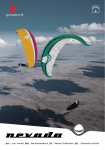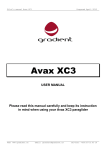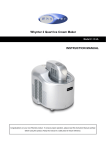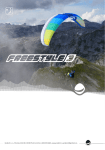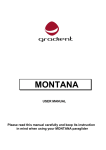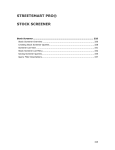Download XC5 user manual
Transcript
Avax [en] - User manual, [de] - Betriebshandbuch, [fr] - Manuel d’utilisation, [cz] - Uživatelská příručka [en] Avax User manual Please read this manual carefully and keep its instructions in mind while using your Avax XC5 paraglider Contents: 1. Introduction......................................................0 2. Your paraglider................................................1 2.1. Technical description....................................1 2.2. Technical data..............................................2 2.3. Materials.......................................................2 3. Certification.....................................................3 4. Adjusting your glider......................................3 4.1. Brake-line lengths.........................................3 4.2. Speed system................................................4 5. Operation in flight.........................................4 5.1. Standard flight regime.................................4 5.1.1. Pre-flight inspection...................................4 5.1.2. Launching...................................................4 5.1.3. Flight...........................................................4 5.1.4. Landing.......................................................5 5.2. Fast descent.................................................5 5.2.1. Big ears.......................................................5 5.2.2. B-line stall..................................................5 5.2.3. Spiral dive..................................................6 5.3. Siv manoeuvres...........................................6 5.3.1. Asymmetric collapse................................6 5.3.2. Full-frontal collapse..................................6 5.3.3. Deep stall...................................................7 5.3.4. Full stall.....................................................7 5.3.5 Negative spin...........................................7 6. Maintaining your glider..................................8 7. Repairing your glider....................................9 8. Enjoy your flying..........................................10 9. Line Map........................................................11 1. Introduction Congratulations on buying a new Avax XC5 – GRADIENT’s latest high-performance wing in the EN-D category. We believe you will be very happy with your new glider in terms of its flight characteristics, exceptional performance and really nice handling. The Avax XC5 is a high-performance XC wing competition glider and therefore it’s meant only for very experienced pilots. Gradient s.r.o., Plzenska 221/130, 150 00 Praha 5, tel+fax +420257216319, www.gradient.cx, [email protected]. 1. This manual provides information which will help you fly safely and keep your wing in good condition. If, after reading this booklet, you have any further questions or uncertainties, please do not hesitate to contact Gradient or any authorised Gradient dealer and we will gladly answer all your questions. We would be pleased to receive your feedback when you get to know your Avax XC5. 2.1. Technical description The Avax XC5’s ground plan has a very slender, elliptical shape with a slight positive contortion of the leading edge. This means that the “ears” (stabilo) of the canopy are slightly swept back in flight. This modern design has a number of advantages. The profile of the glider has been specially developed to deliver maximum stability over as wide a speed range as possible. The position and size of the cell openings help support this objective. The leading edge is reinforced using integrated nylon and elastic. This ensures optimal inflation of the canopy and helps to retain the leading edge’s perfectly clean shape at maximum speed. Attachment points between the lines and the canopy are reinforced by elastic nylon strings, optimising the distribution of forces across the glider. The glider features a unit cell structure with two non-carrying ribs and double diagonal segmented ribs (DD system) that attach directly to the upper surface. This optimises the definition of the top surface curve without losing stability in flight. The arrangement of the speed system and the layout of the line attachment points improve stability at maximum speed – an essential feature of modern high-performance paragliders. The well-proven three-row line concept is used. Main and mid-level lines are unsheeted Edelrid Aramid. Top level lines are unsheeted Liros Dyneema. Every line have UV protection. All lines have the advantage of splice loops to give maximum overall strength, durability and the lowest possible drag. The Avax XC5 is supplied with a special three-riser speed-system which gives great acceleration and maximum speed. The main C-lines are connected to the karabiners with loops, allowing easier adjustment when your glider is serviced by authorised Gradient service centre. Length of the Avax XC5 risers (mm): Size 24 A B C1 C2 Non-accelerated Accelerated Size 26 Non-accelerated Accelerated Size 28 Non-accelerated Accelerated 480 322 480 365 480 420 480 480 A B C1 C2 490 328 490 375 490 440 490 490 A B C1 C2 500 335 500 385 500 460 500 500 Gradient has paid attention to details too, including new low-drag micro attachment points on the wing tips, special karabiners, new rucksack, inner bag and riser bag. 2. 2.2. Technical data Avax XC5 24 26 Flat Area [m2] 21,4 23,5 Projected area [m2] 18,18 19,96 Span [m] 12,2 12,79 Projected span [m] 9,69 10,16 Aspect ratio 6,96 6,96 Projected aspect ratio 5,17 5,17 Max. chord [m] 2,14 2,25 Min. chord [m] 0,44 0,46 Number of cells 66 66 Line consumption [m] 255 268 Weight of the glider [kg] 3,4*/3,7 4,2 Take-off weight range [kg] 70-85 82-97 Optimal take-off weight [kg] 72-82 85-95 Certification EN EN/LTF - D EN/LTF - D * X-Alps version Take-off weight is the weight of the pilot including equipment and paraglider (approx 22-27 kg) 2.3. Materials Canopy Upper sail-leading edge Upper sail-rear part Bottom sail Ribs Reinforcements Reinforcements Reinforcements Attachment points Thread Porcher Marine 70000/70032 Skytex Porcher Marine 70000/70032 Skytex Porcher Marine 70000 Skytex Porcher Marine 70000 Skytex Scrimm F02 420 Dacron F06 391 Hahl Nylon 6, 2/1200 137 128 134AJK000000 Synton 40 Lines-top level Lines-middle level Lines-middle level Lines-middle level Lines-middle level Lines-bottom level Lines-bottom level Lines-bottom level Liros DC 040 Ø 0.5 mm Liros DC 040 Ø 0.5 mm Liros DC 060 Ø 0.6 mm Edelrid Aramid A-8000/U-070 Ø 0,70 mm Edelrid Aramid A-8000/U-120 Ø 0,90 mm Edelrid Aramid A-8000/U-120 Ø 0,90 mm Edelrid Aramid A-8000/U-190 Ø 1,1 mm Edelrid Aramid A-8000-090 Ø 0,8 mm Lines-top level Lines-top level Lines-middle level Lines-middle level Lines-bottom level Lines-bottom level Edelrid Edelrid Edelrid Edelrid Edelrid Edelrid Suspension lines Brake lines Aramid A-8000/U-025 Ø 0,4 mm Aramid A-7000/U-045 Ø 0,45 mm Aramid A-7000/U-045 Ø 0,45 mm Aramid A-8000/U-050 Ø 0,60 mm Aramid A-8000/U-120 Ø 0,90 mm Aramid 7950-200-024 Risers Webbing Pulleys Rings Karabiners 366 043 015 912/01 16 mm Narrow Low fristion ring MRSI03.5 S12 / MRDI03.0 S10 Gradient s.r.o., Plzenska 221/130, 150 00 Praha 5, tel+fax +420257216319, www.gradient.cx, [email protected]. 28 25,7 21,83 13,38 10,62 6,96 5,17 2,35 0,48 66 282 4,6 95-118 105-115 EN/LTF - D 3. 3. Certification The Avax XC5 is EN D certified in all sizes. The EN certificate for each Avax XC5 is on the rib in the middle of canopy. Certification is valid for the use with all ABS harnesses. This type of harness allows a certain degree of adjustment to be made to the length of the waist strap. Between 46 cm and 48 cm is the recommended distance between the karabiners. Equally with all other paragliders, when looser cross-bracing is used while flying the Avax XC5, the pilot’s weight-shift control is greater. The glider is also more sensitive to movement in the surrounding air. When cross-bracing is tighter, the pilot feels subjectively more stable, however turning by weight-shift is less effective. WARNING: The Avax XC5 paraglider is only built for hill or tow launching. It is not built to withstand jumping from a plane, balloon, building or for any jumps where there is a belated opening of the canopy. Use of subsidiary motor (e.g. paramotoring) has not been tested by the manufacturer or by any other testing body. 4. Adjusting your glider Before it reaches the customer, every Avax XC5 goes through a final check and test-flight to verify that its characteristics and measurements correspond to the manufacturer’s specifications. You may only make adjustments to brake-line lengths or to the speed system of your Avax XC5 by following recommendations in this manual. Other adjustments or changes to your Avax XC5 lead to a loss of guarantee, airworthiness and validity of the certification. Do not endanger yourself and other pilots by amateur modification. If you have any suggestions for improvements let us know and our test-pilots will try out your ideas. 4.1. Brake-line adjustment When you receive your new Avax XC5, the main brake lines are adjusted to the length set during the certification test. This length should suit most pilots and is indicated on the main control line. It is of course possible to adjust the brake-line length to suit each pilot’s physical build, height of harness hang points, or style of flying. We recommend that you act wisely when adjusting brake-line length and change the length in small, successive steps. If you need to adjust brakes back to the basic position and the marks on the main brake lines are vague, use the following lengths for relevant size (main brake line consist of two lines 01+02 refer the Avax XC5 - Line Map): XC5 24: 267 cm; XC5 26: 280 cm; XC5 28: 292 cm Brake lines that are too short may: 1) Lead to fatigue from flying with your hands in an unnatural position. 2) Impede recovery from certain unstable manoeuvres. 3) Certainly reduce speed range of your glider. Brakes that are too long will: a) Hamper pilot’s control during launch. b) Reduce control in extreme flying situations. c) Make it difficult to execute a good flare while landing. Each brake line should be tied securely to its brake handle. Use knots which will ensure it won’t get loose, for example, a Double Dragon. 4.2. Speed system The Avax XC5 is equipped with a very effective foot-operated speed system as standard. Pressure on the foot stirrup shortens the A and B risers and releases C1 riser and by this reduces the angle of attack of the canopy. The working range of the speed system pulleys are: XC5-28=16.5 cm, XC5-26=16.2 cm, XC5-24=15.8 cm. Make sure you can use the whole of thiswhen you attach your speed bar. 4. 5. Operation in flight This manual is intended as a guide to the characteristic features of your new Avax XC5 paraglider. Under no circumstances should it be used as a ‘learn-to-fly’ manual for paragliding or as a substitute for a paragliding pilot’s training course. 5.1. Standard flight 5.1.1. Pre-flight check Pre-flight check is essential part of getting ready to fly and that’s why you should pay special attention to it. Check the canopy and lines for damage, clear the lines of any tangles, check the riser maillons, speedbar connectors and don’t forget to check your harness and your reserve parachute. Before you launch spread the canopy out into a slight arc and check that: • all cell openings are free • no lines are looped around or under the canopy • no lines are tangled or have a knot in them • any twigs, grass or other objects are not entangled in the lines or in the canopy • the risers are not twisted • the brake lines run freely through the pulleys • the knots on the brake handles are secure • the karabiners on the risers are tightened 5.1.2. Launching Launching the Avax XC5 is straightforward, either by a forward launch or by reverse launch. A dynamic pull of the front risers (A, coloured red) will bring the canopy simply and easily above the pilot’s head. The canopy inflates from the centre equally and smoothly. The Avax XC5 has no tendency to outrun the pilot and quickly stabilises above the pilot. Once there, visually check the canopy and the lines before taking off. Take off can be easier by a light pull on the brakes. 5.1.3. Flight The Avax XC5 is trimmed to fly at best glide when the brakes are fully up. Best sink rate is achieved when both brakes are bulled down equally to about 20-25% of their range. Turbulent conditions When flying through severe turbulence, stabilise the canopy with simultaneously applying a little brake to both sides. Flying with a little brake applied will also help to prevent deflations and give you more feedback about what the air is doing and how the glider is reacting. Responding correctly to the paraglider’s movement by means of the brakes and weight shift is known as ‘active flying’. A pilot demonstrating good active-flying skills will significantly reduce both the number and severity of collapses he or she experiences. Turning The Avax XC5 is very comfortable and pleasant in turns. Handling characteristics are responsive and accurate and demand no special habits or non-standard procedures. When developing the Avax XC5 special attention was devoted to the brake pressure. The result is that brake travel and pressure have been optimised. Brake pressure is reassuringly progressive. In flight, brakes are firm but responsive and precise and allow for perfect communication with the canopy. You will find that a harness with fairly loose cross-bracing will help the glider turn. In an emergency (e.g. a broken brake line) the glider can be steered with the rear risers or by weight shift. Using the speed system Maximum speed is one of the strong points of Gradient paragliders and the Avax XC5 is no exception. Not only has the glider a very high maximum speed, but unlike some other Gradient s.r.o., Plzenska 221/130, 150 00 Praha 5, tel+fax +420257216319, www.gradient.cx, [email protected]. 5. paragliders the full speed range is useable. Don’t forget that any collapse at full speed will be more severe than the same event experienced at normal trim speed.. Always keep both hands on the controls when flying fast in turbulence and be ready to release the speed system immediately at the first sign of a collapse. Use the speed system very carefully, or not at all at low altitude. 5.1.4. Landing Landing the Avax XC5 is very simple and shouldn’t cause any problem. On your first flights you may be surprised at how well it glides. Take account of this when making your landing approach! Into wind, at about one metre above the ground pull the brakes down all the way. In nil-wind conditions, or if forced to make an emergency landing downwind, you may prefer to take a wrap of each control line to enable a more dynamic flare. 5.2. Fast descent Sooner or later every pilot will need to descend quickly. It might be because of a sudden and unexpected change in the weather, reaching cloudbase and not wishing to enter cloud, or simply because you need to finish your flight quickly. Additionally, if landing is thermic, it is often very difficult to land without using a rapid-descent method. There are three main methods for achieving a rapid descent and they are: Big Ears, B-Line Stall and Spiral Dive. Practise these manoeuvres under the supervision of an instructor and with a reserve parachute. Never compromise your safety. 5.2.1. Big Ears This is the easiest technique for a rapid descent. Depending on how much of the wing tip you deflate, 3 m/s to 6 m/s sink rate can be achieved. While in Big Ears your sink rate and forward speed can be further increased by using the speed system. The Avax XC5 can be steered while Big Ears are in by means of weight shift. Initiation: Grab the outer A-lines on both sides as high as possible and pull them down smoothly. Hold them firmly. The effective area of the glider is reduced equally on both sides of the wing. The size of the deflated area depends on how deeply the lines are pulled down (or on the number of lines pulled – one or two outer lines on both sides). Be sure to pull both sides equally. Recovery: Under normal circumstances the Avax XC5 will open when the A-lines are released. Opening may be accelerated by pumping the brakes gently (repeated symmetrical braking on both sides). 5.2.2. B-Line Stall Depending on how much the B-risers are pulled down, the sink rate is between 5 and 8 m/s. Initiation: Grab the B-risers at the top and smoothly pull them down until the canopy shows a spanwise crease where the B-lines attach to the sail. Your sink rate will increase considerably while your forward speed will decrease ractically to zero. Don’t be startled when the airflow over the top surface is interrupted and the canopy enters a parachutal stall without moving forward. It will soon stabilise above your head. Recovery: On releasing the B-risers the Avax XC5 automatically returns to normal flight without staying in deep stall (sackflug) or shooting in front of the pilot. Let go of the risers smoothly and symmetrically. Caution: Do everything symmetrically and at the same time. If the B-risers are released unevenly the canopy can enter a turn. If the risers are released slowly and very unevenly you could enter a spin. 6. 5.2.3. Spiral Dive The Spiral Dive is the most effective way of making a fast descent. Every pilot should be able to perform a spiral dive and one day you may need to. In a Spiral Dive always stay aware of your altitude, which decreases very rapidly. The sink rate reached in a Spiral Dive can be more than 16-18 m/s. During the manoeuvre the pilot and the glider will experience strong centrifugal forces. Forces greater than 3G are possible – a great strain on the pilot as well as the glider. Initiation: Smoothly pull on one brake so that the glider goes from a normal 360-degree turn into a steep turn and from there into a spiral dive. The transition into a spiral dive can be made easier by weight shifting to the inner side of the turn. Keep an eye on the tension of the brakes all the time: reduced tension signals an overload of the glider and danger of falling into a negative spin. Recovery: The Avax XC5 recovers from a Spiral Dive automatically as soon as the brakes are released. Release them smoothly and always finish a Spiral Dive with safe altitude! Caution: When exiting the Spiral Dive make sure your position in the harness is neutral. Recovery from a Spiral Dive can be delayed if you are weight shifting to the inner side of the turn. 5.3. SIV manoeuvres No matter what category of canopy you fly or what level of certification it has, in turbulence or in strong thermals you may experience all kinds of collapses. The Avax XC5 behaves comfortably in these situations. Indeed not only does the glider deal with extreme flight situations automatically, but it also offers – for its category – an aboveaverage degree of safety. Even so, you must follow all safety rules when practising SIV. Always pay attention to your altitude. Before performing any SIV manoeuvre remember: Practise throwing your reserve on the ground, in a simulator, so that reserve deployment is efficient and automatic. Rapid altitude loss and considerable rotational forces may develop during unstable manoeuvres. Take account of these factors when throwing your reserve. 5.3.1. Asymmetric Collapse – one side of the canopy collapses Initiation: Take hold of the outer A-lines (outer A-riser) on one side and pull them down smoothly. The size of the ear depends on the depth to which the lines are pulled as well as the number of lines pulled down. You can stop any turn tendency by applying the opposite brake and by weight shifting onto the inflated side of the canopy. Recovery: Under normal conditions the Avax XC5 will re-inflate spontaneously when the pulled lines are released. Inflation time and loss of altitude can be reduced by suitable piloting. To stop any tendency to turn off course pull the brake on the inflated side (be careful not to overreact and stall the inflated side) and weight shift to that side. If the collapse remains then re-inflate the collapsed side by ‘pumping’ the brake on the collapsed side. Caution: XC5 has been certified with folding lines. Without using folding lines SIV manoeuvres like Asymmetric collapse and Full Frontal Collapse might be very hard to perform to a desired parameters specified by certification rules. 5.3.2. Full Frontal Collapse Initiation: Take hold of both A-risers at the top and pull them down until the leading edge collapses. Recovery: Recovery time depends on how much of the canopy has collapsed. In normal Gradient s.r.o., Plzenska 221/130, 150 00 Praha 5, tel+fax +420257216319, www.gradient.cx, [email protected]. 7. conditions the Avax XC5 will recover normal flight automatically as soon as the front risers are released. Applying (pumping?)the brakes on both sides simultaneously can help re-open the paraglider. Caution: XC5 has been certified with folding lines. Without using folding lines SIV manoeuvres like Asymmetric collapse and Full Frontal Collapse might be very hard to perform to a desired parameters specified by certification rules. 5.3.3. Deep Stall Initiation: Pull both brakes smoothly until the sink rate increases markedly and the forward speed reaches almost zero. The pull on the brakes should be controlled so that the canopy stays inflated and doesn’t fall back into a full stall. Recovery: The Avax XC5 cannot stay in deep stall flight, so after the brakes are released the glider automatically returns to a normal flight. If you need to, you can accelerate recovery by pulling hard on both brakes, followed by a fast release. Or you can pull lightly on the A-risers. Caution: If you pull too hard on the A-risers you may experience a full frontal collapse. 5.3.4 Full Stall Initiation: Wind the control lines once around your hands and pull both of them down smoothly. Hold them down until the canopy falls behind the pilot and deforms into a characteristic crescent shape. Hold your hands firmly (press them underneath the seat) and be careful that you do not release the brakes prematurely or asymmetrically. Recovery: The Avax XC5 recovers from a full stall automatically once the brakes are smoothly released. During correct recovery from a full stall the Avax XC5 shows no extreme tendencies such as diving in front of the pilot. If the brakes are released prematurely or too quickly there is a possible tendency for the glider to dive ahead of the pilot. This can be corrected by adequate simultaneous braking on both-sides. Caution: When exiting a Full Stall, if the brakes are released asymmetrically the glider may suffer a massive asymmetrical collapse followed by a tendency to enter a spin. 5.3.5 Negative Spin Initiation: Slow down by braking to nearly minimum speed. Then pull a brake on one side all the way down while simultaneously releasing the brake on the other side. Because the stalled side falls back, the canopy suffers airflow disruption over one half of the wing which results in a spin and a rapid loss of altitude. Recovery: Under normal circumstances the Avax XC5 is capable of recovering from a negative spin automatically when the brakes are released. Caution: In general, when there is a very fast or a long-lasting rotation and when the brakes are released too quickly, the canopy may shoot in front of the pilot followed by a massive asymmetrical collapse. Warning: Whenever a paraglider is not in a normal flight and the airflow is disrupted there is always a rapid increase in sink rate and therefore a substantial loss of altitude. Remember: When practising SIV the wrong manoeuvre at the wrong time may change a fairly easy situation into a dangerous problem. You are also exposing your glider to forces that may damage it. Practise SIV manoeuvres only under the supervision of an instructor and with a reserve parachute. 8. 6.Maintaining your glider If you handle your glider with care and store it in a suitable place it can last a very long time. On the other hand, neglecting maintenance, bad storage and the use of unsuitable cleaning products can reduce the lifespan of your glider significantly or may even make it dangerous. You must observe these rules: • Choose a suitable area for your launches. Lines caught on roots or rocks lead to unnecessary strain on the attachment tabs during inflation. Snagging lines may rip the canopy tissue or damage lines. • When landing, never let the canopy fall on its leading edge in front of the pilot. The effect of these forceful collisions and the sudden increase in pressure can severely damage the airresistant coating of the canopy as well as weaken the ribs and seams. • Protect the canopy from unnecessary strain. Inconsiderate handling of your glider – pulling it over grass, soil, sand or rocks – will significantly reduce its lifetime. • When preparing the paraglider for a launch or when ground handling, be sure not to step on any of the lines or the canopy. • Don’t tie any unnecessary knots in the lines. Packing methods where special knots are made in the lines as used on parachutes and reserve parachutes are not suitable for packing the lines used on paragliders. • Protect your canopy and lines from unnecessary exposure to sunlight. UV-rays can damage many parts of a paraglider. • Try not to pack your glider when wet. If it’s unavoidable then dry it as soon as possible but away from direct sunlight. Be careful to avoid storing your canopy wet – this is the most common reason for cloth degradation, and is easily preventable. • Don’t let your glider come into contact with seawater. If it does, rinse the lines, canopy and risers with fresh water and dry before storing. • After flight or when storing always use the inner protection sack. • When storing or during transport make sure your glider isn’t exposed to temperatures higher than 50 degrees Celsius. • Never let the paraglider come into contact with chemicals. Clean the glider with clean lukewarm water only. • When packing the glider we recommend concertina folding the reinforced leading edge to avoid damaging the plastic reinforcements. • For long-term storage don’t pack the glider too tightly. Store it in a cold, dry and wellventilated room. • After tree or water landings always examine the glider carefully. If you suspect that the flight features of your paraglider have changed, contact an authorised Gradient supplier as soon as possible. Aramid unsheeted lines have a working life of a maximum 130 flying hours. After 130 flying hours all lines (except brake lines) must be replaced. • After 130 flying hours or 24 months your Avax XC5 must be thoroughly checked and tested by the manufacturer or by a Gradient authorised service centre. Gradient s.r.o., Plzenska 221/130, 150 00 Praha 5, tel+fax +420257216319, www.gradient.cx, [email protected]. 9. 7. Repairing your glider Only small repairs – i.e. repairs that don’t change the airworthiness of the paraglider – may be done by the user. These include: fixing small tears (but not seams) up to 10 cm; changing damaged lines; and changing rubber line-fixation rings on the small karabiners. When repairing your paraglider on your own keep to the following rules: When repairing the sail use a self-adhesive patch specified for this purpose. Every Avax XC5 comes with a small amount of self-adhesive material which is enough for small repairs. The only admissible repairs done on lines are those where the damaged lines are changed for new ones. Lines must be exclusively supplied by Gradient, an authorised dealer or authorised service centre. When ordering new lines use the codes in the attached line diagram. Use the code ‘XC5’ (Avax XC5) and size of the glider, i.e. ‘XC5 24’, ‘XC5 26’, ‘XC5 28’ followed by the line code. E.g. the outside long line in row A for an Avax XC5 28 is: ‘XC5 28 A 1.3.’ An exception to this is an emergency repair while out flying. For this purpose Gradient encloses a spare line with every Avax XC5 with a prepared loop on one end. To get the right length adjust it accordingly to the same line on the opposite side of the canopy. As soon as you can, change the line for an original one from your authorised Gradient service centre. After changing any lines a thorough pre-flight check must be done. Don’t hesitate to ask your instructor or an experienced colleague for help. If you’re not sure, entrust the job to either the manufacturer or an authorised Gradient dealer. If you have to replace any of the line-tidy rings (a spare ring is supplied with each Avax XC5) check that the lines haven’t been swapped accidentally and that they are returned to the small karabiner in the correct order. Gradient Avax XC5 – Diagram & Dimensions 10. 8. Enjoy your flying Even though the Avax XC5 has outstanding performance and stability it must be understood that even the safest paraglider is an aircraft and that all air sports can be relatively dangerous. Remember that your safety lies in your own hands and that it’s always your responsibility to be well prepared. Never underestimate weather conditions. And never forget that you are flying for pleasure and not to become a ‘fallen hero’. Remember this and the fun that only free-flying can bring will be yours. We believe that your sensible attitude and the flight characteristics of your Avax XC5 will combine to ensure you have many hours of fantastic flying. For all our gliders we are using Porcher materials which are made under environmental laws of EU and all the coating has to be environmental friendly. When your glider get to the end of its life we recommend to use Porcher recycling Program to dispose it. GRADIENT wishes you many fabulous flights and happy landings. Ondřej Dupal Cyprián Koreň Gradient s.r.o., Plzenska 221/130, 150 00 Praha 5, tel+fax +420257216319, www.gradient.cx, [email protected]. 4 1 3.1 3 3.1 2 3.1 3.1 0 2.6 3.1 2.6 2 3.1 3 .11 0 2.5 3.9 2 2.5 2.5 3.1 3.8 1 2.5 3.9 1.3 2.4 3.7 1.3 3.7 3.8 3.6 2.4 1.2 2.3 3.5 0.2 3.5 1.2 2.3 3.6 B 9. Gradient Avax XC5 – Line Map 0.1 1.1 3.4 1.1 3.4 R 3.3 3.3 2.2 2.2 3.2 3.2 2.1 3.1 2.1 3.1 3.1 2.1 3.2 3.1 2.2 3.2 3.3 1.1 2.1 3.4 3.3 1.1 3.5 2.2 3.4 1.2 2.3 A 3.6 3.5 2.4 3.6 3.7 3.7 1.2 2.3 3.8 1.3 C 2.4 3.8 3.9 1 2.5 3.9 0 3.1 2 2.5 2.5 2 1 3.1 3.1 1.3 1 2.5 0 3.1 1 3.1 2.6 S 2.5 2 2.5 2 3.1 3 3.1 2.6 3 3.1 4 3.1 4 1.1 3.1 3.1 2.2 2.1 3.2 2.3 3.3 3.4 3.5 3.6 11. Avax Gradient s.r.o. Plzenska 221/130 Tel.+Fax +420 257 216 319 [email protected] www.gradient.cx















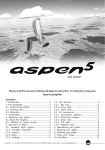
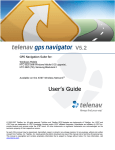
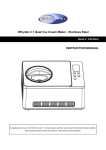
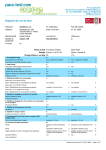




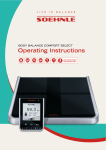
![[en] - User manual, [de] - Betriebshandbuch, [fr]](http://vs1.manualzilla.com/store/data/005845053_1-6d1995608e49c7f1600fcad0c20a630a-150x150.png)
